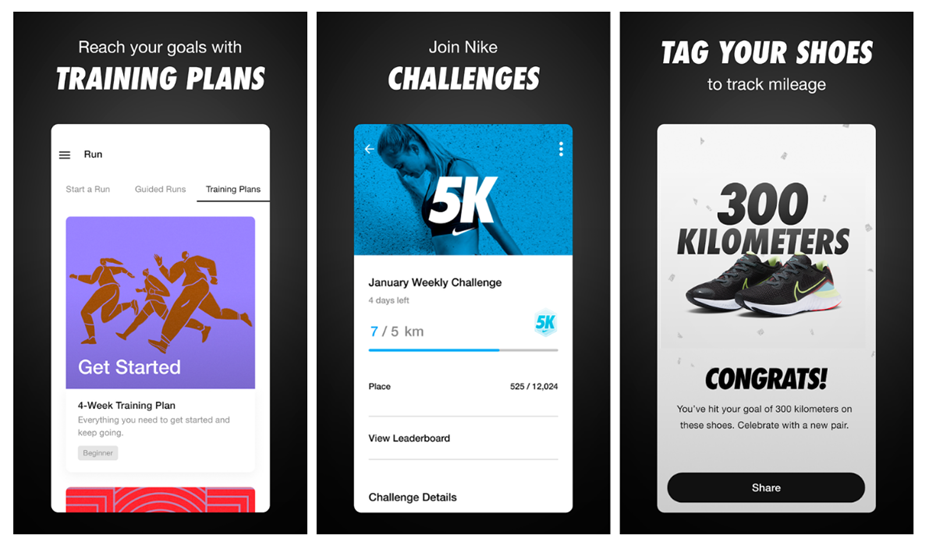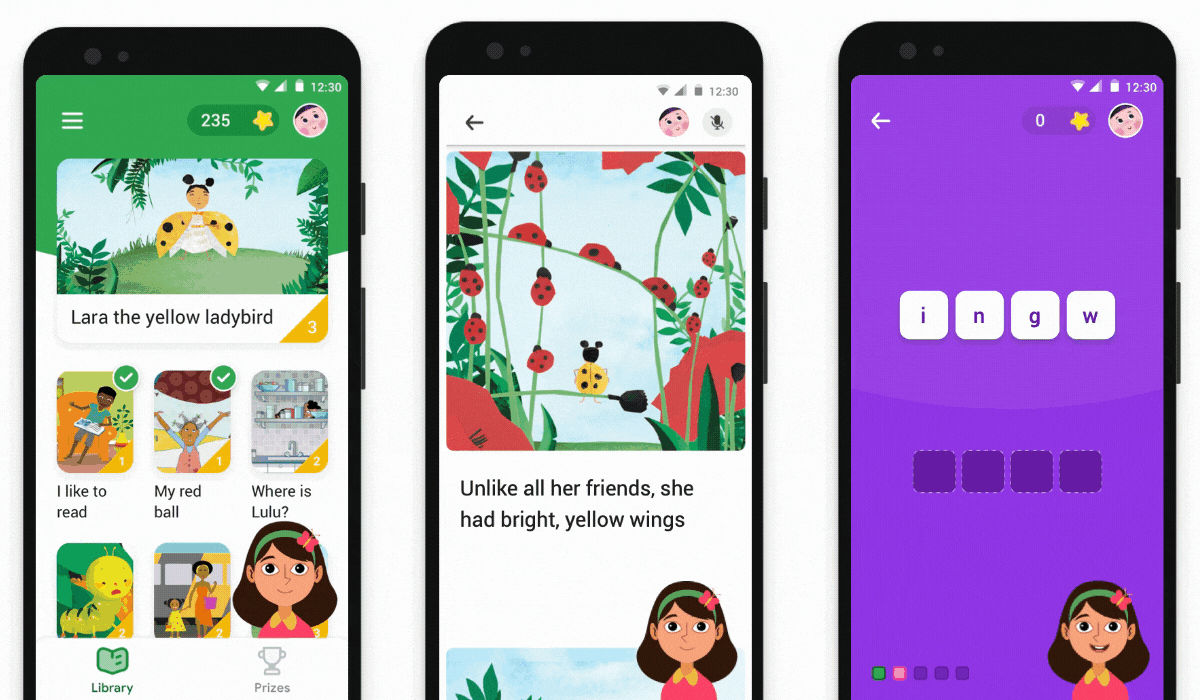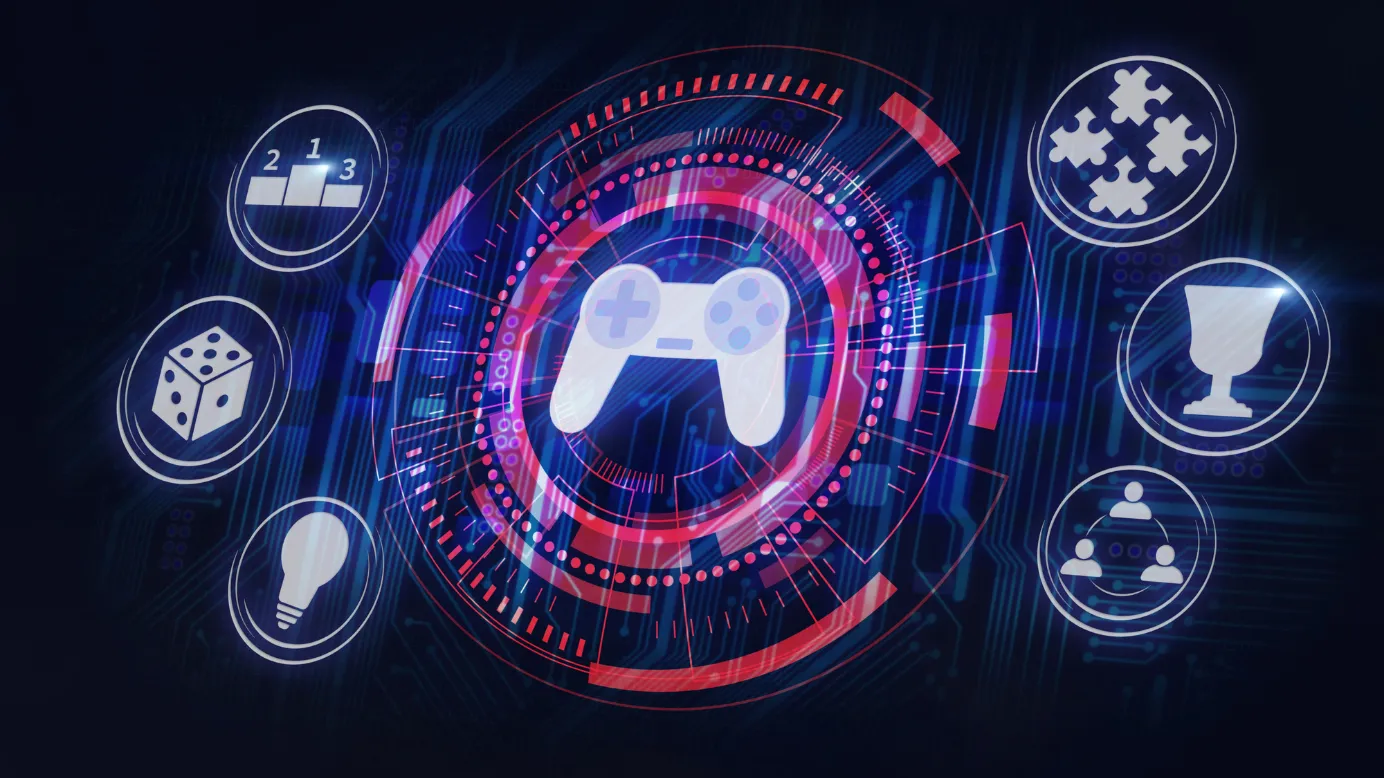Comment jouer avec l'apprentissage pour améliorer les résultats de l'apprentissage ?
Qu'est-ce que la ludification de l'apprentissage et comment la rendre efficace ? Plongez dans l'univers des mécanismes de jeu tels que les points, les classements et les défis qui peuvent transformer des leçons ennuyeuses en voyages passionnants, améliorant ainsi l'engagement, la motivation et les résultats de l'apprentissage.
Sur cette page
- Qu'est-ce que l'apprentissage par le jeu ?
- Qu'est-ce que la gamification ?
- Différence entre la gamification et l'apprentissage par le jeu
- Défis posés par les programmes d'apprentissage dans différents cas d'utilisation
- La gamification dans l'apprentissage
- Les éléments de la gamification et comment les utiliser dans l'apprentissage
- Principes clés de la ludification de l'apprentissage
- Exemples de marques utilisant la gamification et le GBL (Game-Based Learning) dans leurs applications
- Comment les intégrations LMS peuvent vous faire gagner du temps et rationaliser votre activité
Imaginez un monde où chaque défi vous permet d'obtenir des récompenses, où chaque tâche accomplie est applaudie et où vous débloquez de nouveaux niveaux simplement en repoussant vos limites. Cela vous semble familier ? C'est le plaisir de jouer à un jeu.
Nous avons tous connu les joies du jeu : courir après les points, franchir les obstacles et s'efforcer de gagner. Qu'est-ce qui fait que nous restons accrochés ? Trois choses : l'engagement, l'intérêt et l'implication.
Lorsque vous êtes vraiment engagé, vous donnez le meilleur de vous-même et cette énergie est puissante, qu'il s'agisse de développement personnel ou d'apprentissage. Imaginez maintenant que vous appliquiez cette même expérience de jeu à quelque chose de traditionnellement ennuyeux, comme l'apprentissage. L'impact ? Il change la donne.
C'est le pouvoir de la gamification, unestratégie éprouvée adoptée par les entreprises, les écoles et les organisations pour rendre l'apprentissage et la croissance plus passionnants et plus efficaces.
Ceci étant dit, nous allons comprendre les détails de l'apprentissage par le jeu et de la gamification, les défis à relever pour susciter l'engagement dans vos programmes d'apprentissage, la manière dont l'apprentissage incitatif peut surmonter les points faibles et bien plus encore.
Qu'est-ce que l'apprentissage par le jeu ?
L'apprentissage par le jeu est une approche d'apprentissage actif qui utilise des jeux pour enseigner des compétences spécifiques et atteindre des résultats définis. Il rend l'apprentissage amusant et engageant en fournissant un espace sûr pour appliquer les concepts - comme les simulations de transactions boursières en économie. L'apprentissage par le jeu est aujourd'hui largement utilisé dans les formations en entreprise pour développer des compétences dans des domaines tels que le service à la clientèle, la technologie et le travail d'équipe.
Qu'est-ce que la gamification ?
La gamification est le processus qui consiste à incorporer des mécanismes ou des éléments de jeu dans une expérience globale afin d'en augmenter le plaisir ou l'engagement.(Source : Mind Research Institute)
La gamification consiste à ajouter des éléments de jeu à des activités qui n'en sont pas afin de déclencher des comportements spécifiques chez l'utilisateur. La gamification transforme un processus d'apprentissage particulier en un jeu. Elle utilise des éléments et des mécanismes de jeu à appliquer dans les cours d'apprentissage pour engager et motiver les apprenants.
Il est intéressant de noter que n'importe quelle activité peut être gamifiée, et que cela ne se limite pas à l'apprentissage. Des applications de fitness aux plateformes financières, les stratégies d'apprentissage gamifiées sont omniprésentes.
Voici quelques exemples de mécanismes de jeu :
- Points
- Récompenses
- Badges de réussite
- Barres de progression
- Classements
- Niveaux/questionnaires
Il est intéressant de noter que toute activité peut être gamifiée, et que cela ne se limite pas à l'apprentissage. C'est pourquoi les choses que vous utilisez au quotidien - des applications de fitness aux applications financières en passant par vos pages LinkedIn - tout est gamifié pour stimuler la participation des utilisateurs et accroître l'engagement.
Différence entre la gamification et l'apprentissage par le jeu
Alors que l'apprentissage par le jeu (GBL) transforme l'ensemble du processus d'apprentissage en un jeu, la gamification utilise les jeux comme partie intégrante du processus d'apprentissage.
Les organisations adoptent de plus en plus l'apprentissage par le jeu pour stimuler la rétention, améliorer les performances et rendre le contenu plus accrocheur.
La principale différence entre l'apprentissage par le jeu (GBL) et la gamification est l'inclusion de mécanismes de jeu dans le contenu de la formation. Étant donné que l'apprentissage basé sur le jeu intègre les deux, le jeu est en fait la formation elle-même. En revanche, la gamification utilise des éléments de jeu comme récompenses pour compléter les modules de formation.
|
Application de l'apprentissage par le jeu (GBL) |
Application de la gamification |
|
Dans l'apprentissage par le jeu, les apprenants comprennent de nouveaux concepts et mettent en pratique leurs compétences.
l'apprentissage par le jeu, les apprenants comprennent de nouveaux concepts et pratiquent leurs
compétences dans un environnement sans risque. Les progrès sont directement associés à la
compréhension du sujet enseigné. |
La gamification intègre des outils d'engagement
au contenu existant pour motiver les apprenants. Si l'ajout de barres de progression ou de niveaux à un contenu existant semble assez simple, les choses deviennent plus complexes.
niveaux à un contenu existant semble assez simple, les choses deviennent complexes
lorsque vous placez les participants sur des tableaux de classement (par exemple) ou que vous leur attribuez des points lorsqu'ils donnent des réponses correctes.
points à chaque fois qu'ils donnent des réponses correctes. |
|
GBL a pour objectif de rendre l'apprentissage amusant. Il a un impact considérable sur les taux de mémorisation et de rétention des apprenants.
a un impact considérable sur les taux de mémorisation et de rétention des apprenants. Ici, les utilisateurs sont engagés et intéressés par le sujet,
les utilisateurs sont engagés et intéressés par le sujet. Lorsque le taux d'engagement
Lorsque le taux d'engagement augmente, cela a également un impact sur la rétention. |
La gamification a pour but de susciter
l'engagement. Les éléments de la gamification s'appuient sur le besoin qu'a l'être humain
de compétition, de collectionner et de réussir. |
|
Le GBL donne à l'apprenant la liberté de
de pratiquer ou d'appliquer les compétences qu'il a acquises sans aucune implication dans le monde réel.
Les utilisateurs reçoivent un retour d'information qui leur permet de savoir s'ils se débrouillent bien et d'affiner leurs compétences avant de les appliquer dans le monde réel.
leurs compétences avant de les appliquer dans le monde réel. C'est un aspect que les
LMS (Learning Management Systems). |
GBL donne aux apprenants la liberté de
de pratiquer ou d'appliquer les compétences qu'ils ont acquises sans aucune
sans aucune implication dans le monde réel. Les utilisateurs reçoivent un retour d'information qui leur permet de savoir s'ils se sont bien débrouillés et d'affiner leurs compétences avant de les utiliser dans le monde réel.
et d'affiner leurs compétences avant de les utiliser dans le monde réel. Il s'agit là d'un aspect
que les systèmes de gestion de l'apprentissage (LMS) résolvent. |
|
Voici quelques exemples d'applications : Révision de la politique Formation au service à la clientèle Formation en entreprise Formation de sensibilisation du personnel Renforcement de l'esprit d'équipe |
Voici quelques exemples d'applications : Innovation de produits Embarquement Engagement dans le programme de L&D Élimination des erreurs commises par les employés Apprentissage collaboratif |
Défis posés par les programmes d'apprentissage dans différents cas d'utilisation
Les avantages de l'apprentissage engagé sont nombreux. Qu'il s'agisse d'une école ou d'une organisation, tout le monde préfère un engagement accru, de meilleurs taux d'achèvement, une plus grande rétention et une plus grande satisfaction.
Avec les nombreux avantages de l'engagement de l'apprenant - probablement suffisants pour convaincre - vous pouvez vous demander pourquoi un facteur aussi crucial que l'"engagement" est si difficile à atteindre ? La raison en est que certains obstacles complexes se dressent sur la voie d'un engagement accru de l'apprenant.
Comprenons les défis des programmes d'apprentissage dans différents cas d'utilisation.
1. Difficultés rencontrées par les entreprises avec leurs employés lors des programmes de formation
Lorsqu'il s'agit de programmes de formation en entreprise ou de programmes de L&D, l'attention ne suffit pas. Malheureusement, la majorité des responsables L&D sont confrontés à de multiples défis qui ont des solutions immédiates, mais qu'ils ne parviennent pas à mettre en œuvre au bon moment.
Voici quelques défis communs aux programmes de formation en entreprise :
- Approche unique : Forcer les apprenants à suivre le même chemin ne fonctionne pas. Laissez-les choisir leur formation en fonction de leurs intérêts afin d'atteindre les objectifs plus rapidement.
- Logiciel d'apprentissage compliqué : Dans le cas d'une formation à distance, l'assistance est limitée. Un LMS convivial avec des outils d'auto-assistance, des tutoriels et des démonstrations fait une grande différence.
- Faible taux d'achèvement des cours : Un accès flexible à la formation ne suffit pas. Ce qui manque, c'est la motivation.
- Le manque d'engagement : L'apprentissage seul n'est pas toujours gratifiant. Offrir des récompenses significatives et recueillir des commentaires stimule l'engagement et la participation.
- Des récompenses ennuyeuses ou sans intérêt : Les récompenses génériques ou inadaptées (comme les bons d'achat pour animaux de compagnie pour les personnes qui n'en possèdent pas) peuvent être démotivantes. Les récompenses doivent être personnalisées et adaptées au lieu.
- Pas d'éléments compétitifs : Sans points, rangs ou interactions entre pairs, les apprenants manquent de motivation. La gamification maintient la motivation à un niveau élevé.
- Récompenses différées : La gratification des mois plus tard perd de son impact. La reconnaissance instantanée par le biais de systèmes de récompense intégrés permet aux apprenants de se sentir appréciés immédiatement.
Au lieu de modules ennuyeux, l'apprentissage par le jeu offre aux apprenants un objectif à atteindre : des badges, des classements ou même des récompenses.
2. Difficultés rencontrées par les enseignants avec les étudiants dans le cadre des programmes d'apprentissage en ligne
Même si l'évolution de la technologie a permis beaucoup de choses que nous n'aurions jamais pu imaginer, le changement soudain de l'apprentissage en ligne et du comportement des étudiants après la pandémie n'a pas été aussi facile que les écoles/enseignants/formateurs/professeurs/éducateurs l'auraient souhaité. Rencontrer les pièges de l'apprentissage en ligne peut être frustrant pour les étudiants comme pour les enseignants.
Voici quelques défis communs aux programmes d'éducation ou d'apprentissage en ligne :
- L'utilisation d'un LMS obsolète : Les apprenants d'aujourd'hui s'attendent à des plateformes intuitives et modernes, et non à des systèmes encombrants et dépassés. Un LMS terne peut désengager même les étudiants les plus curieux. Un LMS interactif et facile à naviguer est essentiel pour stimuler la participation et les résultats de l'apprentissage.
- Le manque de motivation pour apprendre : Les élèves n'apprennent pas efficacement s'ils ne sont pas motivés. L'intégration de récompenses, de jetons et de marques d'appréciation pour les étapes franchies leur donne le coup de pouce dont ils ont besoin pour rester engagés et obtenir de meilleurs résultats.
- L'absence de défi ou de compétition : Sans défi ni compétition saine, l'apprentissage devient passif. L'apprentissage basé sur les défis favorise un engagement plus profond et pousse les élèves à repousser leurs limites.
- Ne pas utiliser une approche de microapprentissage : Les leçons longues et denses peuvent submerger les étudiants. Le microapprentissage, qui consiste à partager le contenu en petits morceaux ciblés, facilite l'absorption des informations et maintient l'intérêt des étudiants.
3. Défis rencontrés par les prestataires de services d'apprentissage avec leur LMS
Les prestataires de services linguistiques opèrent sur un marché concurrentiel et exigeant. Bien que chaque entreprise soit différente, les défis posés par le marché sont similaires.
Voici quelques défis auxquels sont confrontés les prestataires de services d'apprentissage :
- Des objectifs peu clairs : Lancer un LMS sans objectifs bien définis entraîne des retards, de la confusion et des attentes non satisfaites. Avant l'implémentation, clarifiez vos points de douleur, votre public et les résultats souhaités.
- Faible interaction avec l'utilisateur : Si les utilisateurs n'aiment pas utiliser le LMS, l'engagement diminue. Fournissez des documents d'accueil et de formation clairs pour minimiser les frictions et augmenter la satisfaction.
- Manque de flexibilité : Un LMS inflexible limite l'évolutivité et l'intégration. Les plugins tiers permettent d'automatiser les tâches, de personnaliser l'apprentissage et d'assurer la conformité - les manquer est une opportunité manquée.
- Pas de personnalisation : Un SGA générique ne permet pas de répondre aux différents besoins des apprenants. La personnalisation - comme l'envoi de récompenses localisées ou de fonctions de motivation - est essentielle pour l'engagement et l'efficacité.
- Pas d'incitations pour les apprenants : Sans récompenses ou défis ludiques, les apprenants manquent de motivation. L'e-learning incitatif entraîne un changement de comportement, mais il nécessite un LMS robuste et évolutif pour gérer la complexité.
La gamification dans l'apprentissage
Qu'il s'agisse d'employés, de clients, de formateurs ou d'étudiants, la gamification est l'une des stratégies les plus influentes et les plus brillantes pour motiver les gens. Déclencher ces désirs humains avec la gamification peut engager et améliorer l'expérience globale d'apprentissage des apprenants.
Comprenons-le à l'aide d'un exemple simple.
Supposons que l'on vous confie la tâche d'amener un groupe d'enfants à effectuer deux tâches sans recourir à la force :
- Tâche 1 : Demander aux enfants de terminer leurs devoirs
- Tâche 2 : Demander aux enfants de lire un livre
Le feront-ils ? Non.
L'heure de l'étude n'est pas du tout divertissante. Nous sommes tous passés par là lorsque nous étions enfants. C'est ennuyeux à mourir. Mais imaginons que l'on demande à ces enfants de jouer à des jeux au lieu d'étudier. Quel serait alors le résultat ? Ils seraient prêts à jouer toute la nuit, sacrifiant leur repas préféré et une bonne nuit de sommeil sans se plaindre. Pourquoi ?
C'est le plaisir de vivre des expériences qui sont bien meilleures et plus divertissantes que les études. Des éléments tels que le déblocage de nouveaux niveaux de jeu et l'accomplissement de choses au fur et à mesure de la progression sont ce qui les incite à rester.
Supposons maintenant que vous ayez la possibilité de combiner des éléments de jeu et d'éducation. Quel serait alors le résultat ? Les mêmes enfants seront plus enthousiastes à l'idée de lire un livre ou de finir leurs devoirs volontairement. C'est le potentiel caché de l'apprentissage par le jeu.
Les éléments de la gamification et comment les utiliser dans l'apprentissage
Les récompenses, les classements, les badges ou tout autre élément susceptible de motiver ou de satisfaire un apprenant sont appelés éléments de jeu.
Là encore, ces éléments sont classés en deux catégories : La mécanique du jeu et la dynamique du jeu.
1. Mécanismes du jeu
Les mécanismes de jeu sont utilisés pour ludifier un processus (ou un contenu dans le cas d'utilisation de l'apprentissage). Ils permettent d'orienter le comportement de l'utilisateur grâce à des points, des récompenses, un retour d'information et d'autres types d'incitations. Ce sont les fondements de toute entité non gamifiée.
La liste des mécanismes de jeu comprend :
- Rangs et niveaux
- Scores et classements
- Badges et trophées
- Tâches individuelles ou en équipe
- Monnaie virtuelle
- Défis et déverrouillages
- Tableau de bord visualisé
- Avatars et profils individuels
2. Dynamique du jeu
Les mécanismes de jeu ont le pouvoir de motiver l'utilisateur, mais l'inconvénient est que cela ne dure qu'un temps. Lorsque les choses deviennent répétitives, les utilisateurs s'ennuient à nouveau. C'est là que la dynamique du jeu joue un rôle essentiel. La dynamique du jeu associe le comportement de l'utilisateur aux mécanismes du jeu, ce qui permet de les faire évoluer au fil du temps et d'éviter que le jeu ne devienne monotone.
La liste des dynamiques de jeu comprend
- Collaboration
- Compétition
- Progrès
- Réalisations
- Récompenses
- Collection
Principes clés de la ludification de l'apprentissage
La ludification de l'apprentissage offre de nombreux avantages, mais son succès dépend d'une mise en œuvre adéquate. Chaque organisation étant unique, ce qui fonctionne pour l'une peut ne pas réussir pour l'autre.
La stratégie idéale peut varier considérablement en fonction des besoins individuels et des attentes du processus. Voici quelques facteurs essentiels à prendre en compte lors de l'élaboration d'une stratégie de gamification :
- Des objectifs clairs et précis : L'efficacité de l'apprentissage par le jeu dépend de la qualité de la définition des objectifs et des mécanismes de retour d'information, comme l'indique une étude psychologique menée par Research Gate. Pour obtenir des résultats optimaux, les attentes doivent être parfaitement claires et le retour d'information doit rester cohérent. Par exemple, si vous mettez en place un système de points, les employés doivent comprendre parfaitement les règles et l'importance de gagner ces points. Les points attribués ou non doivent également être clairement expliqués.
- Suivi des progrès : Il est essentiel d'établir une mesure transparente et facile à lire pour suivre les progrès. Les entreprises peuvent choisir de mesurer les performances à l'aide de différentes mesures telles que des badges, des points ou des tableaux de bord pour donner un aspect ludique à l'exercice. En outre, en communiquant les récompenses de chaque processus bien à l'avance, on s'assure que les employés comprennent ce qui est en jeu et on maintient leur motivation.
- Défi et compétition : Si le fait d'encourager une saine concurrence entre les employés peut rendre le travail plus attrayant et plus agréable, les organisations doivent garder le contrôle du processus. Les tâches et les défis doivent être conçus en gardant à l'esprit un équilibre, en les rendant ni trop faciles, ni trop difficiles. Si la concurrence commence à engendrer des rivalités ou des conflits malsains, les employeurs doivent intervenir rapidement pour atténuer les sentiments désagréables ou les différends.
- Collaboration : Promouvoir le travail d'équipe parallèlement à la compétition peut se faire par le biais de jeux d'équipe réguliers. Cette approche améliore les relations au sein de l'équipe et encourage la résolution de problèmes en collaboration.
Exemples de marques utilisant la gamification et le GBL (Game-Based Learning) dans leurs applications
Voici quelques exemples de marques de renom dans le monde entier qui ont connu le succès après avoir appliqué la "gamification" à leurs applications.
1. Nike
En 2010, Nike a lancé son Nike Run Club, une plateforme de gamification qui a connu un grand succès auprès de ses utilisateurs. L'application a été conçue pour aider à suivre et à gamifier le temps de course d'un utilisateur, ses niveaux de santé, la distance parcourue et les fonctions permettant de se comparer à ses enregistrements précédents ou à d'autres personnes dans le domaine social.
Le succès de cette application est dû à l'utilisation pure et simple de la gamification. Des tableaux de classement, des récompenses, des badges et des systèmes de points attrayants ont permis de susciter l'engagement souhaité.

Le Run Club de Nike est l'un des exemples classiques de micro-mesure des progrès et de retour d'information en direct pour aider les coureurs à s'améliorer et à progresser dans la réalisation de leurs objectifs personnels quotidiens.
2. Google Read Along
Le récent lancement de Google's Read Along est un parfait exemple de la manière dont la combinaison de l'apprentissage par le jeu et de la gamification rend l'apprentissage efficace pour les utilisateurs finaux. L'application a été lancée dans le but de soutenir les familles du monde entier en rendant l'apprentissage accessible.

Conçue pour les enfants de plus de 5 ans, l'application utilise la technologie de la reconnaissance vocale pour développer les capacités de lecture et d'écriture. Elle est disponible en 9 langues dans 180 pays afin de la rendre plus accessible. Elle maintient l'intérêt des enfants grâce à une collection variée d'histoires passionnantes et de jeux interactifs qui les accompagnent.
Les enfants peuvent collectionner des badges et des étoiles au fur et à mesure qu'ils apprennent, ce qui les motive à continuer à lire et à jouer. Il aide également les parents à créer des profils pour différents lecteurs qui, lorsqu'on les touche, donnent un tableau de bord montrant les progrès de chacun d'entre eux.
Comment les intégrations LMS peuvent vous faire gagner du temps et rationaliser votre activité
"Intégrations transparentes" est un terme que vous entendrez souvent lorsque vous chercherez le bon LMS, et ce pour une bonne raison. Un bon LMS doit se connecter sans effort à vos outils existants, sinon vous vous retrouverez avec des limitations et de la frustration.
Imaginez que vous ayez un LMS qui ne peut pas intégrer les récompenses ou qui n'a pas de connectivité CMS. Bien sûr, vous pourriez demander un développement personnalisé, mais c'est coûteux, long et complexe.
C'est là que les intégrations LMS deviennent essentielles. Elles agissent comme le moteur qui permet des opérations plus fluides, une expérience utilisateur améliorée et des décisions plus intelligentes.
Pourquoi les intégrations LMS sont importantes :
- Synchronisation sans effort avec des outils et des API tiers pour une flexibilité maximale.
- Permettre le partage des données entre plates-formes pour une meilleure connaissance de l'apprenant et de l'impact de la formation.
- Gagnez du temps et de l'argent en rationalisant les flux de travail et en réduisant les tâches manuelles.
- Soutenir des décisions éclairées et évolutives pour développer efficacement votre écosystème d'apprentissage.
Les intégrations API sont l'arme secrète pour des programmes d'eLearning et de formation d'entreprise plus intelligents, plus rapides et plus évolutifs.
En connectant votre LMS à des outils tiers tels queGoogle Analytics, des CRM ou des plateformes de récompenses, vous débloquez une automatisation qui vous fait gagner du temps, un partage de données transparent et un reporting sans effort. De l'inscription automatique des nouveaux employés au suivi des performances en temps réel, les API permettent à votre LMS d'en faire plus, avec moins d'efforts.


















